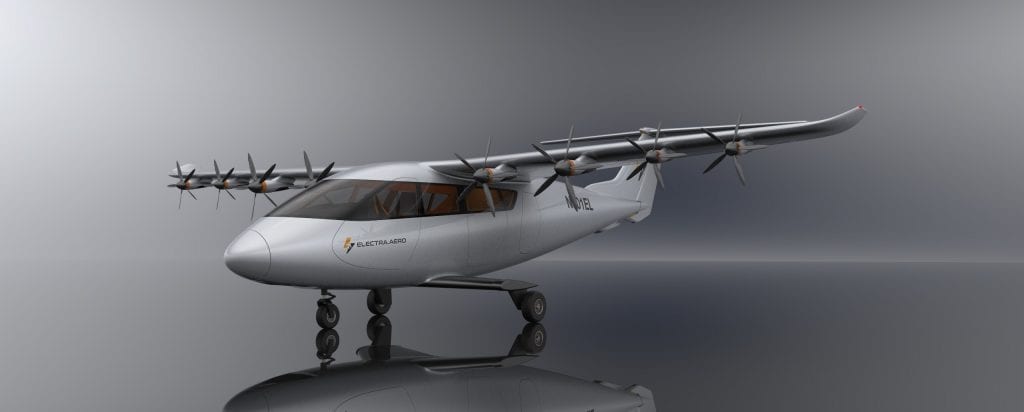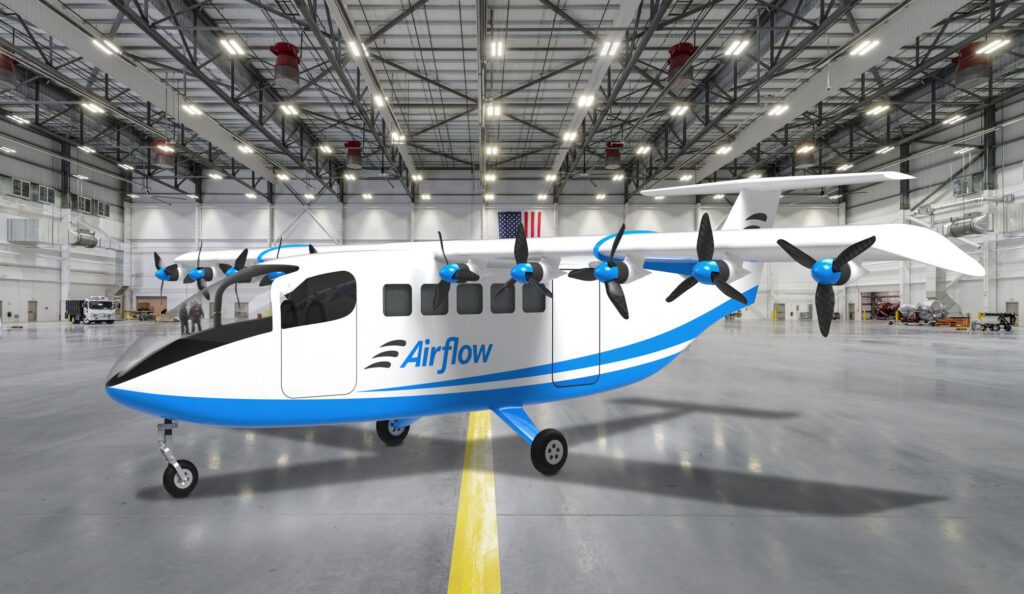
Jaunt Air Mobility is opening design and manufacturing operations in Canada. (Jaunt Air Mobility)
In the electric air taxi world, there are two aircraft designs that are emerging: electric ultra-short takeoff and landing (eSTOL) aircraft and electric vertical takeoff and landing (eVTOL) aircraft. The differences between these two aircraft center around takeoff however the technologies that enable their unique takeoff styles give each aircraft design different advantages and disadvantages in their flight characteristics.
Experts in the industry say there is enough space in the industry for both eSTOL and eVTOL aircraft designs to be successful; different mission capabilities will decide if these aircraft are complementary or competitors.
“I'd like to say that in aircraft today and with electric aircraft in the future, there will be many types of aircraft, there will be many winners, and so I think there's plenty of room in this market moving forward for both eVTOL and eSTOL,” Marc Ausman, CEO and co-founder of Airflow.Aero, said during a panel at AIAA’s Propulsion Energy Forum. “There's areas where they overlap, and there's areas where they'll have different missions that they'll each be successful in.”
While Ausman says he is a fan of both aircraft designs, he is a bigger fan of eSTOL. Airflow has is developing two eSTOL aircraft variations that will have ranges between 250 miles and 500 miles with payload capacities up to 2,000 lbs. These aircraft will only need between 150 and 250 feet to takeoff and land.

Shown here, Electra's ultra-short takeoff and landing aircraft can deliver nearly triple the payload capacity, an order of magnitude longer ranges, and less than half the operating costs. Electra is the most sustainable choice for advancing urban and regional air mobility. (Electra)
Electra.aero is also developing an eSTOL aircraft that uses a technique called blown lift. Electra’s eSTOL aircraft will be able to carry seven passengers and a pilot and will have a range of 500 miles.
“Blown lift achieves the short takeoff and landing through highly controlled slow speed flight,” John Langford,” founder and CEO of Electra.aero, said during the panel. “It's really the combination of the distributed electric propulsion, and the blown lift that we think is transformational in this...One of the big things that we have to kind of get our heads around is the idea that these are airplanes that have wings but don't necessarily use runways. Sure they can use runways, but they're not required to use runways.”
The benefit to the eSTOL designs is they do not require the same amount of energy that vertical takeoffs allowing them to have greater range and payload capacity.
“eVTOLs use electric propulsion to take off and land vertically – many of these concepts then transition from vertical flight to forward flight with a wing providing the lift once in cruise,” Ben Marchionna, director of technology and innovation at Electra.aero, told Aviation Today in June. “Vertical flight requires significantly more power, resulting in an enormous payload, range, and cost penalty. eSTOLs use electric propulsion and an aerodynamic technique called blown lift to takeoff over distances as short as 100 feet. This provides eSTOL aircraft access to many of the same urban air mobility markets.”
Ausman also said that the blown lift technique makes eSTOL aircraft highly maneuverable and allows for very powerful control movements.
“I don't know where this idea that you can't maneuver eSTOL airplanes comes from,” Ausman said. “They are very highly maneuverable, and in fact, the blown lift works to your advantage in that...you get very powerful control moments, both from blowing the aerodynamic surfaces and also from thrust vectoring. You have a number of propellers and you can control the thrust from each so you get both the lift augmentation and the control.”
On the other side of the debate, eVTOLs take off vertically like a helicopter versus the short airplane-like takeoff of eSTOL aircraft. While eSTOL aircraft are able to take off from very short runways, eVTOLs only need enough space for the length of the aircraft, such as a helipad.
Mark Moore, who co-founded Uber Elevate and is now the CEO of Whisper Aero, said he spent many years during his time at NASA designing eSTOL concepts. However, he now believes that the eVTOL design concept is the better route.
“For years at NASA, I was pushing for eSTOL to make sense, and I came up with all sorts of crazy concepts and they're crazy because it's such a difficult design problem if you're targeting 100-foot ground roll,” Moore said during the panel. “My opinion is, it's way, way harder to achieve that with an eSTOL than it is to develop an eVTOL.”
Moore said one of the issues he finds with eSTOL aircraft is the ability to create enough drag to hit really small runway targets. He also says the aircraft has to have an abort capability.
“There's not just a design problem, there's huge operational challenges as well,” Moore said. “...You have to have an abort capability all the way until the wheels touchdown, and you've got to make sure that you don't end up on the backside of the power curve as you reaccelerate to get out.”

In January, Airflow announced that they would be moving from sub-scale model testing to a new testing phase using a remodeled Cessna 210. (Airflow)
While Ausman argued that eSTOLs do not have challenges with tight maneuvers, Moore disagreed.
“You’ve got to worry about eSTOL, they don't want to be doing tight turns,” Moore said. “You don't want to be doing turns when you're coming in really low and slow...eVTOL can do that all day because it's pure powered lift, it's not the dependent on the wing lift.”
Wind could also cause issues with eSTOLs as they are attempting landings, Moore said.
“The biggest problem is dealing with winds, right,” Moore said. “If you're coming in at 30 miles per hour and you’ve got a tailwind, you just lost almost 50 percent of your lift, and so that's a real challenge.”
The eVTOL aircraft design could also provide for fewer noise emissions which will be important in urban environments. Moore said the propellers on eSTOL that are designed for high induced velocities to generate the extra lift for takeoff and landing usually have small diameter propellers that create noise that human ears are most adapted to hearing. This means that eVTOL can actually make more noise but at a different frequency that is less bothersome to the human ear.
“Even though the eVTOL is making 10 times more thrust, it's eight DB quieter, but because of the frequency that it's making the noise because of the small diameter props, it sounds like it's 20 to 30 DB,” Moore said. “...If you're trying to get quiet, those mid-frequency to higher frequency noise are really bad where it's like you're paralyzed on the order of 20 DB. So you really don't want to be making noise in that vocal range...because the human ear is optimized to hear those frequencies the best.”
Jaunt Air Mobility is developing an eVTOL aircraft. Martin Peryea, CEO of Jaunt Air Mobility, said his team reconfigured their aircraft design to compare the capabilities of eVTOL versus eSTOL.
“I had our team kind of look at reconfiguring this particular aircraft, the Jaunt Journey, into a short takeoff and landing aircraft,” Peryea said. “I think everybody realizes you can certainly get some performance benefit of running down a runway and taking off, especially with a main rotor system.”
They found that there were some added capabilities with eSTOL aircraft which made him believe that both of these aircraft designs have a place in the current market.
“So you get about twice the capability out of an eSTOL aircraft, which is not surprising,” Peryea said. “You can trade some of that way, you know, for additional battery capability...We used a fairly short takeoff distance, we looked at a couple of different takeoff distances here, it doesn't really move the needle, a whole lot in terms of the capability from the payload range perspective, I think, I think we also left it off at 75 feet in this particular case...So, there is a market, actually, in my opinion for both types of these aircraft here.”
Peryea said he believes eVTOL aircraft will be better in low-speed and high wind conditions. However, the aircraft configuration will also play a big role.
“From my perspective, in my opinion, the eVTOL aircraft, we're gonna have better handling quality characteristics at low speed and high gust wind conditions than your short takeoff aircraft,” Peryea said. “You'll have sufficient, you know, control power available to you, and it certainly is going to be dependent on the configuration of the aircraft.”
"electric" - Google News
August 19, 2021 at 06:00PM
https://ift.tt/2XuQe0b
Is the Electric Air Taxi Market Big Enough for eSTOLs and eVTOLs? - Aviation Today
"electric" - Google News
https://ift.tt/2yk35WT
https://ift.tt/2YsSbsy
Bagikan Berita Ini















0 Response to "Is the Electric Air Taxi Market Big Enough for eSTOLs and eVTOLs? - Aviation Today"
Post a Comment